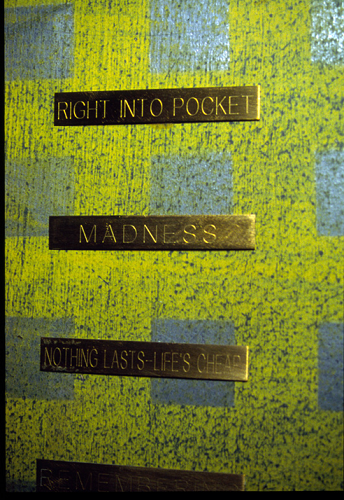What strikes
you first about Carlos Villa’s artwork is the abundance of lines. Sharp and
straight, they slice through his massive wooden canvases like pinstripes, and cross
like dense city grids. The curved ones layer on top of another, tracing the musculature
of a face, or worming around a canvas seemingly aimless. The work is abstract -- all
form and no referents at first glance -- until certain signs begin to reveal
themselves. Above an intersecting axis hangs a fedora, a symbol of an early
generation of Filipino men who migrated to the West Coast. Alongside a grid are
street names -- Kearny, Montgomery, Washington -- names that mark the vanishing
geography of Manilatown, San Francisco. There’s history in these pieces -- a
Filipino American history of migrants, empire, and selfhood -- but its traces
only emerge after you look closely.
Villa’s artwork
is the subject of the recently edited collection Carlos Villa and the Integrity of Spaces. Theodore Gonzalves,
the book’s editor and a professor at the University of Maryland, Baltimore
County, isn’t coy about his opinion of Villa. He is, Gonzalves writes, the most
significant US-based visual artist of Filipino descent of the twentieth century. Others in the volume
attest to Villa’s impact. Moira Roth describes Villa’s presence in the Bay Area
as “casting spells for […] two decades,” not only as a superb artist but as a
legendary teacher. And David A. M. Goldberg, one of the artist’s collaborators,
compares Villa to Public Enemy and graffiti artists, grounded as all three are
in repurposing the idioms of style and the streets. Yet, for the most part, in
the halls of academia (in art history and ethnic studies departments, alike), Villa’s
work has gone unnoticed. Carlos Villa and
the Integrity of Spaces tries to correct that through a series of critical
essays and artistic tributes to his career, both from folks in the academic
world and from long-time friends and activists.

Villa grew
up in San Francisco’s Tenderloin district, in what he describes as “a Filipino
ghetto side by side with a Japanese ghetto, in the middle of a Black ghetto.” Born
in the immediate aftermath of the Tydings-McDuffie Act, which reclassified
Filipinos from “US nationals” to “aliens,” Villa’s art explores this formative era
of Filipino settlement in the US with an eye for both political critique and
communal remembering. And though his projects celebrate that earlier generation
of immigrants, Villa’s engagement with the past is never wrought by sentimentality. Gonzalves explains, “Villa is unsparing [with]
the flaws that he saw in many of his parents’ generation -- whether it had to
do with compulsive gambling or womanizing or alcoholism. […] Of
course, he’d be the first to tell you that his parents’ generation lived and
worked in a time when racism was the law of the land.” In his
installation series My Uncles
(1993-96), for instance, Villa used the metaphor of “doorways” to comment on the
constantly shifting immigration policies toward the Filipino community; quite
literally, too, framed doorways, painted black and affixed with fedoras and photos
of the manong generation, stood in
the middle of a gallery, deliberately leading the spectator nowhere.
It took years,
however, before Villa developed an aesthetic that could meaningfully engage
Filipino identity. Villa’s earliest work was born out of San Francisco’s
abstract expressionist school, which, despite its ethos of freeing the artist
from formal conventions, still constrained his ability to explore the various
facets of his cultural roots -- tribal, national, and regional. Using different
media and materials, interestingly, is what finally allowed him a way in. In an
interview with Margo Machida, Villa explains, “I started using blood along with
my acrylic paint… [as well as] shells, hair, broken mirrors. I started
extending what I knew of modernism to what I just discovered about these
cultures. And in some way, I was trying to bring about an answer or a way that
I could become Filipino American.” In Worlds
in Collision (1994), Villa makes another revealing comment about his
process: “I have always striven for a gumbo, for a creolization of aesthetics
in my own work.”
That
“gumbo” approach to aesthetics, in a way, describes Villa’s ideas on art
education. Since 1969, Villa has taught at the San Francisco Art Institute,
where he has been a pioneer and tireless advocate of multicultural art
education. To be sure, Villa’s “multicultural” isn’t limited to a tepid politics
of inclusion -- what Goldberg describes as the soft multiculturalism of
“sharing food, fashion, and tunes.” His is a far more radicalized
multiculturalism that begins by recognizing the intersections between different
communities of color. Gonzalves explains that Villa’s attempts at fleshing out multicultural
art history had “less to do with adding brown faces to predominantly white
spaces,” and more to do with community building across the city.
So why
have critics overlooked Villa’s body of work? Why is not that complicated, Gonzalves
insists, and is symptomatic of a broader erasure from American public memory of
US imperial relations to the Philippines. “Every academic discipline still
functions much like those guilds of the past -- one group of specialists
training another,” Gonzalves tells me, and “[i]f most ‘Americans’ have no idea
about the meaning and context of events like the Spanish-American or US-Philippine
Wars, you can bet that art historians would know much less.” Carlos Villa and the Integrity of Spaces
is an important book for that reason alone: it not only celebrates the work of
an artist and educator who has inspired so many, but it gives us a way to
engage the “political consciousness” of even Villa’s most abstract art. You can’t
see Tydings-McDuffie, Manilatown, and the manongs
of Kearny Street in the lines of Villa’s giant canvasses, until you learn to
read its signs.
(Visit
Carlos Villa’s website
for more information)
* * *
Manan Desai recently completed his PhD at the University of Michigan, and currently serves on the board of directors for the South Asian American Digital Archive.









Comments